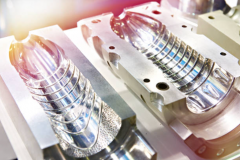You see water bottles everywhere. At the gym, in your office, even at your kid’s soccer game. But have you ever stopped to think about how they’re made? It’s a pretty cool process called molding. Let’s take a closer look.
Type Of Molding Is Used To Make Water Bottles

Molding is a way to shape things. For water bottles, we usually use plastic. There are two main types of molding we use: injection molding and blow molding.
Injection Molding
Imagine making a sculpture out of plastic. That’s what injection molding is like. We start with small plastic bits called resin. We heat them until they melt. Then we inject the melted plastic into a mold. The mold is the shape of the water bottle. Once the plastic cools down, it hardens. And voila! We have a water bottle.
This method is great because it’s precise and efficient. It lets us make intricate designs and keep the quality consistent. This is especially important for making caps and lids. They need to fit just right to keep the bottle sealed.
Blow Molding
Blow molding is a bit different. We start with a hollow plastic tube called a parison. We put the parison into a mold. Then we blow air into it. The plastic expands and takes the shape of the mold. After it cools down, we open the mold. And there’s our water bottle!
This method is perfect for making bottles with even thickness and shape. It’s often used for single-use water bottles you find at the store. Blow molding is cost-effective and versatile, which makes it great for making lots of bottles at once.
Why Molding is Awesome?
There are several reasons why molding is a great way to make water bottles:
– It’s cost-effective: Because we can make lots of bottles at once, it brings down the cost per bottle. That means you can buy water bottles without breaking the bank.
– It’s customizable: We can change the design, size, and color of the water bottles to match what you want.
– It’s sustainable: Many water bottles made through molding can be recycled. This helps reduce plastic waste and is better for the environment.
How are water bottles molded?

Have you ever wondered how your everyday water bottles come to life? Let’s take a fun journey through the process of water bottle molding!
Step 1: Picking the Material First, we pick a special material to make water bottles. It’s called polyethylene terephthalate (PET). PET is safe for storing drinks and we can recycle it easily.
Step 2: Melting the PET We start by heating PET pellets. They melt into a thick liquid. This liquid will soon turn into our bottles.
Step 3: Putting the PET into Molds Next, we put the melted PET into molds. You can think of molds as big, hollow shapes that we fill up.
Step 4: Cooling Down After we fill the molds, we cool them down quickly. This makes the melted PET harden into the shape of the mold. It’s like magic!
Step 5: Opening the Mold When the mold cools down, we open it up. Inside, we find a brand new water bottle. It’s like opening a surprise gift!
Step 6: Trimming and Finishing But we’re not done yet! Our bottle needs some finishing touches. We trim it and smooth it out to make it perfect.
Step 7: Putting on Labels Now it’s time to make our bottle unique! We put on labels with designs and information. This includes the brand name and recycling symbols.
Step 8: Checking the Quality Before our bottles go to the stores, we check them carefully. We remove any bottles that aren’t perfect. We want to make sure you get the best ones!
Step 9: Packing Up Once we approve the bottles, we pack them up. They’re ready to go to stores near you. They’re all set to help you stay hydrated on the go!
Step 10: Ready to Use And there you have it – a perfectly made water bottle ready for you to use. It’s been quite a journey from the factory to your hands!
Final Words
To wrap up, making water bottles is a fascinating process. We melt PET pellets, put them into molds, cool them down, trim them, label them, check their quality, pack them up, and finally, deliver them to you. It’s a simple but detailed process. It makes sure you always have safe and reliable water bottles when you need them.

